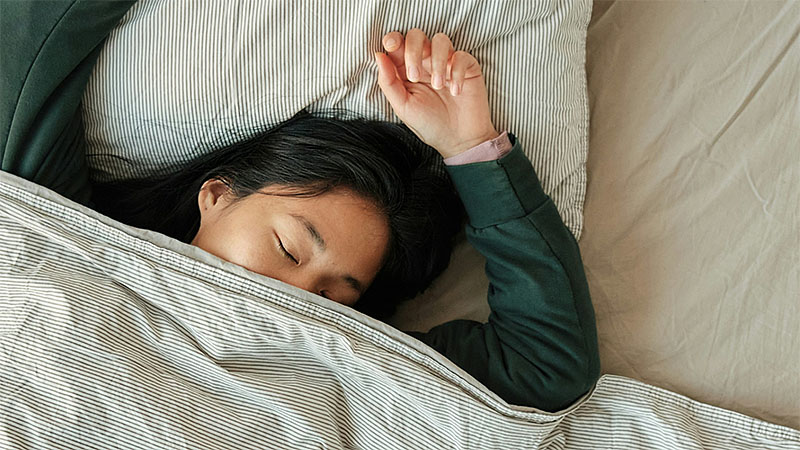Sleep, well-being and our biological clock

A better rhythm: better health
Long before clocks and other time measurement existed, the human body followed the sun: waking with dawn, winding down at dusk. That rhythm still lives within us, guiding processes like sleep, energy, and digestion through 24-hour cycles called circadian rhythms.
Central to this system is the suprachiasmatic nucleus (SCN), the brain’s ‘master clock.’ It coordinates and synchronizes thousands of smaller clocks found in nearly every organ.1
But in modern life, the line between light and dark has completely blurred. Things like bright screens, artificial lighting, and working the night shift disrupt the natural course of day and night, and that impacts our internal rhythms. If our clocks fall out of sync with what is going on around us, the consequences can become noticeable throughout the body.
Light: The Timekeeper
Your circadian system runs on a roughly 24-hour cycle, but it needs social or environmental cues to stay in sync with the passing of the day. These signals are also called timekeepers or zeitgebers. They can include things like what time you eat, when you exercise, or how late you work. But the single most powerful timekeeper is light.1-4
When light enters the eye, it activates specialized retinal cells that contain a pigment called melanopsin. These cells send direct signals to the SCN, telling your brain that it’s daytime.5,6 With this input, the SCN coordinates the timing of physiological processes throughout the body, like:
- Signaling the adrenal glands to release cortisol in the morning to promote wakefulness and the ability to start the day alertly.7,8
- Raising body temperature and heart rate to prepare you for daytime activity.3,8
- Suppressing melatonin, the sleep hormone, until the next night.1,9
- Stimulating hunger, metabolism, and digestion during daylight hours.6
As evening approaches and light levels fade, the SCN triggers the pineal gland, a tiny powerhouse in the brain responsible for making and releasing melatonin, helping your body prepare for sleep.7,10

The Problem with Artificial Light
Today, the line between day and night is often severely blurred. LED bulbs, smartphone screens, and late-night streaming flood our evenings with ‘blue light’; the same wavelength of light that tells the brain it's daytime.
The wavelengths that make up blue light are three times more powerful at cutting melatonin levels than those at the other end of the light spectrum. Blue light can increase your heart rate, make you feel more alert, and raise your body temperature, none of which is helpful if you’re trying to fall asleep.1
In fact, research has shown that evening exposure to blue light delays melatonin onset by up to 90 minutes and reduces total melatonin levels.11,12
The result: it’s harder to fall asleep, sleep is lighter and shorter, you’ll be less alert, and your mood is also affected.
Even the lights in your home can have this effect. In one study, ordinary room light before bedtime suppressed melatonin by about 85% compared to dim light conditions.13
What exactly does melatonin do?
Although melatonin is a hormone that is produced at night, it’s not a sedative. Melatonin acts as an internal signal, telling your body to begin the physiological processes that occur during the nighttime phase of your 24-hour cycle.14 These include:
- A drop in core body temperature (especially of the core), which helps you fall asleep and stay asleep.15 This also ensures lower energy consumption.1
- A decrease in blood pressure as your heart rate slows, your blood vessels dilate, and your nervous system calms.16
- Metabolism slows and shifts toward cellular repair and restoration.17
- Antioxidant defenses are strengthened, protecting tissues from oxidative stress.18,19
When evening light exposure reduces your ability to make melatonin, these processes are delayed or even weakened. Your body misses its internal signals, leading to lighter sleep, hormone disruption, and decreased restoration.1,20
The Health Benefits of Living in the Right Rhythm
Sleep is a vital part of your body's 24-hour rhythm. It benefits literally every process in the body. Here is how strong 'circadian alignment' benefits your health:
1. Metabolism and weight. Circadian rhythms control when your body is most efficient at metabolizing glucose and burning fat.1 Eating late at night, when melatonin is rising, throws off this balance, meaning insulin sensitivity drops, blood sugar rises, and calories are more likely to be stored as fat.1,21 Studies show that shifting meals to earlier in the day can improve insulin sensitivity and support weight management, even without changing total calories.22,23
2. Hormone balance. Cortisol, growth hormones, thyroid hormones, and reproductive hormones all follow circadian cycles. Chronic disruption of these cycles, such as staying up late under bright light or sleeping irregular hours, affects these rhythms, contributing to fatigue, mood instability, and metabolic dysfunction.1
3. Brain and mood. The timing of your internal clock affects how your brain regulates mood and cognition. Late-night light exposure and melatonin suppression are linked with higher rates of anxiety and depression.24 Healthy, consistent sleep set to your circadian rhythm strengthens emotional resilience and memory.1
4. Immune function and repair. At night, your body goes to work repairing cells, regenerating tissue, reducing inflammation, and activating your immune system.1 When circadian timing is disrupted, inflammatory markers rise, and immune responses weaken.25
5. Longevity. Emerging research suggests that consistent circadian alignment – regular sleep-wake cycles, timed light exposure, and stable daily routines – might extend lifespan by reducing oxidative stress and maintaining gene stability.26,27

Out of Sync? Restore Your Rhythm
If your rhythm is out of balance, there is fortunately a 'simple' and highly effective solution:
1. Get morning light. Step outside within an hour of waking. Even 10-15 minutes of sunlight helps suppress leftover melatonin, boosts mood-regulating serotonin, and sets your circadian clock for the day. Early day exercise/effort also strengthens the circadian 'wake-up signals'.
2. Keep daylight bright. Throughout the day, increase exposure to natural light or bright indoor lighting to reinforce your daytime signal. This increases alertness and helps your body produce melatonin more predictably at night.
3. Dim the evening. Two to three hours before bedtime, lower lights and minimize screen time. If you use devices, activate night modes or wear blue-light-blocking glasses.
4. Give your sleep a fixed rhythm. As much as possible, try to go to sleep and wake up at the same times, even on weekends. Consistency and regularity are the foundations of good sleep.
5. No screens before bed. Put down your phone, step away from your computer, and turn off the television at least an hour before bedtime.
6. Respect darkness. At night, keep your environment as dark as possible. Use blackout curtains or an eye mask. Avoid bright bathroom or hallway lights if you wake up during the night.
7. Align meals and movement. Eat your main meals during daylight hours and plan dinner at least three to four hours before bedtime.
Circadian Rhythms in Medicine
Chronotherapy is an emerging approach in medicine that tailors treatment to the body's natural circadian rhythms. Instead of giving medications at arbitrary times, scientists are studying when the body is most – or least – responsive to a particular therapy.
Some studies have shown that the timing of chemotherapy can influence both its effectiveness and its side effects.28 Research shows that giving high blood pressure medications at night better aligns with the body's blood pressure patterns, leading to improved cardiovascular health.29 This same approach is also being explored in the management of asthma and autoimmune diseases, where timing of medication can influence disease activity and treatment response.30
As research expands, the goal is to harness the body's internal clock to make therapies more precise, effective, and gentler on the system – a new dimension of truly personalized medicine.
This blog article is a translation and adaptation of a Take 5 Daily article on Thorne.com
Thorne Author: Brent Bauer, M.D., Mayo Clinic
NL Editor: Peter Smeets
Published on: November 14, 2025
1. Morgenthaler TI, Kolla BK. Mayo Clinic Guide to Better Sleep. Mayo Clinic Press; 2025.
2. Blume C, Garbazza C, Spitschan M. Effects of light on human circadian rhythms, sleep and mood. Somnologie (Berl). 2019;23:147-156.
3. Duffy JF, Czeisler CA. Effect of light on human circadian physiology. Sleep Med Clin. 2009;4:165-177.
4. Dibner C, Schibler U, Albrecht U. The mammalian circadian timing system: organization and coordination of central and peripheral clocks. Annu Rev Physiol. 2010;72:517-549.
5. Hastings MH, Maywood ES, Brancaccio M. Generation of circadian rhythms in the suprachiasmatic nucleus. Nat Rev Neurosci. 2018;19:453-469.
6. Kalsbeek A, la Fleur S, Fliers E. Circadian control of glucose metabolism. Mol Metab. 2014;3:372-383.
7. Czeisler CA, Gooley JJ. Sleep and circadian rhythms in humans. Cold Spring Harb Symp Quant Biol. 2007;72:579-597.
8. Buijs RM, Kalsbeek A. Hypothalamic integration of central and peripheral clocks. Nat Rev Neurosci. 2001;2:521-526.
9. Arendt J. Melatonin: characteristics, concerns, and prospects. J Biol Rhythms. 2005;20:291-303.
10. Spitschan M. Melanopsin contributions to non-visual and visual function. Curr Opin Behav Sci. 2019;30:67-72.
11. Bonmati-Carrion MA, Arguelles-Prieto R, Martinez-Madrid MJ, et al. Protecting the melatonin rhythm through circadian healthy light exposure. Int J Mol Sci. 2014;15(12):23448-23498.
12. Silvani MI, Werder R, Perret C. The influence of blue light on sleep, performance and wellbeing in young adults: a systematic review. Front Physiol. 2022;13:943108.
13. Gooley JJ, Chamberlain K, Smith KA, et al. Exposure to room light before bedtime suppresses melatonin onset and shortens melatonin duration in humans. J Clin Endocrinol Metab. 2011;96(3):E463-E472.
14. Arendt J. Melatonin: characteristics, concerns, and prospects. J Biol Rhythms. 2005;20:291-303.
15. Claustrat B, Brun J, Chazot G. The basic physiology and pathophysiology of melatonin. Sleep Med Rev. 2005;9:11-24.
16. Casagrande M, Favieri F, Langher V, et al. The night side of blood pressure: nocturnal blood pressure dipping and emotional (dys)regulation. Int J Environ Res Public Health. 2020;17:8892.
17. Cipolla-Neto J, Amaral FG, Afeche SC, et al. Melatonin as a hormone: new physiological and clinical perspectives. Endocr Rev. 2018;39:990-1028.
18. Reiter RJ, Tan DX, Galano A. Melatonin as an antioxidant: under promises but over delivery. J Pineal Res. 2016;61:253-278.
19. Melhuish Beaupre LM, Brown GM, Kennedy JL, et al. Melatonin’s neuroprotective role in mitochondria and its implication in antioxidative processes and repair. Transl Psychiatry. 2021;11:473.
20. Wahl S, Engelhardt M, Schaupp P, et al. The inner clock – blue light sets the human rhythm. J Biophotonics. 2019;12:e201900102.
21. Garaulet M, Qian J, Florez JC, et al. Melatonin effects on glucose metabolism: time to unlock the controversy. Trends Endocrinol Metab. 2020;31:192-204.
22. Sutton EF, Beyl R, Early KS, et al. Early time-restricted feeding improves insulin sensitivity, blood pressure, and oxidative stress even without weight loss in men with prediabetes. Cell Metab. 2018;27:1212-1221.e3.
23. Qian J, Scheer FAJL. Circadian system and glucose metabolism: implications for physiology and disease. Trends Endocrinol Metab. 2016;27:282-293.
24. Guindon GE, Murphy CA, Milano ME, Seggio JA. Turn off that night light! Light-at-night as a stressor for adolescents. Front Neurosci. 2024;18:1451219.
25. Baxter M, Ray DW. Circadian rhythms in innate immunity and stress responses. Immunology. 2020;161:261-267.
26. Bass J, Lazar MA. Circadian time signatures of fitness and disease. Science. 2016;354:994-999.
27. Acosta-Rodríguez VA, Rijo-Ferreira F, Green CB, et al. Importance of circadian timing for aging and longevity. Nat Commun. 2021;12:2862.
28. Amiama-Roig A, García-Ruiz A, García-González J, et al. Chronotherapy: circadian rhythms and their influence in cancer therapy. Cancers (Basel). 2022;14:5071.
29. Hermida RC, Ayala DE, Mojón A, et al. Bedtime hypertension treatment improves cardiovascular risk reduction: the hygia chronotherapy trial. Eur Heart J. 2020;41:456-463.
30. Ursini T, Manzoli L, Congedo G, et al. Chronobiology and chronotherapy in inflammatory joint diseases. Pharmaceutics. 2021;13:1832.
